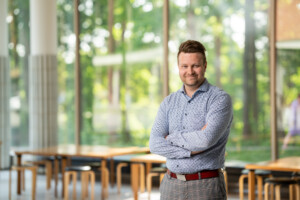At the University of Jyväskylä, project culture is systematically developed with a focus on action. The Thinking Portfolio Project Portfolio was adopted to provide the organization with better and more unified situational awareness regarding ongoing projects aimed at developing operations.
Jaakko Sivusuo, Development Manager at the University of Jyväskylä, was involved as a project manager in implementing the Thinking Portfolio and is now its primary user. He trains the university staff in using the Project Portfolio and focuses on developing the organizational project culture, especially through projects aimed at operational development.
The aim is a reproducible organization, not individual heroic performances.
At the University of Jyväskylä, the goal of developing project culture is not to become a “heroic performance organization” but to genuinely achieve reproducibility.
Jaakko divides project culture development into four main aspects: practices, people, technology, and leadership. According to him, it’s advisable to initially focus on actions and their management. Only after defining the operational methods in the project world and training people is it time to open the box of technology.
“When considering the development of project culture, at some point, portfolio management and unified situational awareness inevitably come into play. Thinking Portfolio and portfolio management became relevant for us when there was a need to create a more unified view of what is happening at the university,” says Jaakko.
“When considering the development of project culture, at some point, portfolio management and unified situational awareness inevitably come into play.
The technical adoption of the tool initiates a more challenging phase: internal adoption within the organization.
The technical implementation of the Thinking Portfolio tool went well from the customer’s perspective.
“We had a good feeling about it – the supplier took the lead in implementation, and things progressed smoothly. We achieved results, and the process wasn’t erratic,” says Jaakko, mentioning that schedules were agreed upon with the supplier and adhered to. “We even made prioritizations regarding where time should be allocated. We always knew in advance what needed to be done before the workshop, what would happen during it, and what would follow,” Jaakko says.
Once the technology is ready, a more challenging phase for many begins: implementing the tool within the organization.
At the University of Jyväskylä, training on portfolio usage occurs monthly and as needed, although the system is considered user-friendly. Portfolio users are given a lot of power and responsibility: there are few mandatory fields, so users can evaluate which fields they find useful from a project and management perspective.
“Everyone has the power and responsibility to manage their own work.”
Jaakko believes that motivation for using the tool comes from leadership. Leadership needs to provide feedback on the project manager’s reporting for it to be considered meaningful.
“We also have some practice in this area, and the adoption of the operating model is in its early stages. Developing project culture also requires changes in leadership. Similarly, successful adoption of Thinking Portfolio requires changes in the organization’s operating model and leadership,” Jaakko says.
“Three things happen in an organization naturally: ambiguity, conflict, and underperformance. Everything else requires leadership. When I say leadership, I don’t mean just leaders leading but everyone having the power and responsibility to lead their own work,” Jaakko says.
The Project Portfolio enables better, fact-based decisions.
At the University of Jyväskylä, the Project Portfolio is seen as an enabler. Systematic use of the portfolio enables more effective achievement of strategic goals and provides unified situational awareness, prioritization, resource allocation, and decision-making.
“If you don’t know what’s happening, what do decisions, resource allocation, and prioritization rely on?”
Special emphasis was placed on configuring the portfolio with regards to project strategic connections and impacts. The portfolio displays connections between projects and the university’s capability areas, strategic development programs, and cross-cutting goals of the strategy, as well as unit development programs.
“The portfolio enables a lot of things. If you don’t know what’s happening, what do decisions, resource allocation, and prioritization rely on? The portfolio acts as an enabler to make better decisions – fact-based decisions. The portfolio enables data-driven management and transparency.”
Access to the university’s portfolio is granted to everyone for visibility into information. There’s a clear rationale for this: unified situational awareness does not bring harm.
Supporting the implementation and continuing to develop project culture
Currently, at the University of Jyväskylä, the focus is on supporting the portfolio’s implementation. This involves change communication, sharing situational information, and developing project culture. Misconceptions diminish, and knowledge accumulates.
“Learning something new might feel unpleasant or like there isn’t time to fill in mandatory fields. Once I timed it, filling in basic information took five minutes. You have to be a tough cookie if you can’t find five minutes in a year,” Jaakko laughs.
The long-term goal is for the decisions made and prioritization to be clearly visible in the portfolio. The idea is that next year, board and strategy reporting could happen through the Project Portfolio’s strategy connection tab. The aim is to enhance communication effectiveness and strengthen transparency. Jaakko believes that portfolio management is also a way to acknowledge the value of management decisions when the decisions made are concretely visible in the prioritized projects in the portfolio.
Based on a interview with

Jaakko Sivusuo
Head of Development and Portfolio Management
University of Jyväskylä
Text: Tyyne Taunila, Marketing Specialist, Thinking Portfolio








